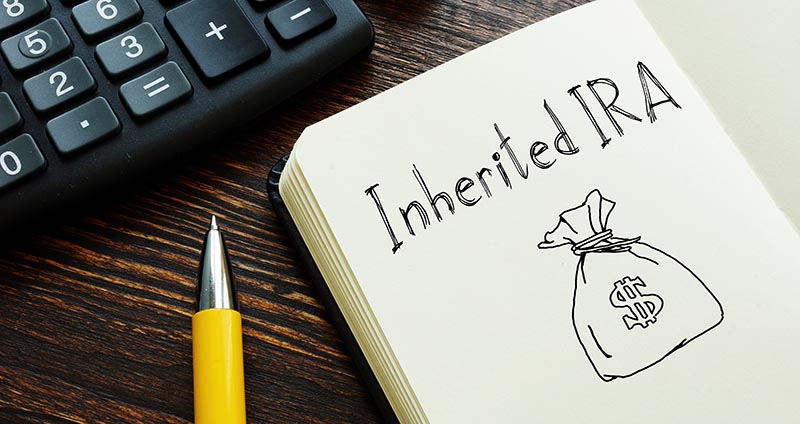Tax Treatment of Inherited IRAs
July, 05 2021 by Carolyn Richardson, EA, MBA
In 2020, a pandemic ravaged the United States and other parts of the world, killing more than 600,000 people in the U.S. alone. If one of your loved ones came down with COVID-19 and unfortunately passed away from it, or died from other reasons, you may have recently inherited an individual retirement account (or IRA) from a spouse or another relative such as a parent. It is fairly common knowledge that inheritances are generally not taxable to the person who receives money from the deceased (called a beneficiary). You may have also heard of a tax provision called the “stepped up basis” rule, which revalues inherited property – like your mother’s house - at the current fair market value for determining if a gain or loss is incurred on the sale of the inherited property. But can you inherit an IRA and not pay any tax on it using these rules? The simple answer is no. Individual retirement accounts do not get a stepped up basis, even if there are assets such as real estate in the account, but they can transfer to a beneficiary without any immediate tax consequences if no money is withdrawn from the IRA. Because IRA accounts are already largely in cash or readily marketable securities and the fair market value is determined annually, the value on the date of death is easy to determine and is easy to distribute to any beneficiaries. However, because the vast majority of IRA funds were contributed to the IRA through “pre-tax” dollars, withdrawals from an inherited IRA are subject to income tax on the beneficiary’s tax return. This is different than inheriting something like a savings account from your parent, which would be transferred to the beneficiary without any taxes.
Of course, if your dad had a self-directed IRA so he could invest in a small business or rental properties, that may not be the case but that type of issue is also not going to be discussed in this blog. We are going to discuss the rules for the more common type of retirement account, which is invested in stocks or mutual funds.
 So, if you inherited an IRA account, what should you report for your own taxes? The tax consequences will depend on who you inherited the IRA account from. You generally will inherit the IRA from your spouse or someone else. If the account is inherited from a spouse, you have more tax options with the IRA account than you would have if the account is inherited from another relative or a friend. If you inherit the account from someone who is not your spouse, this is usually referred to as being a “non-spouse beneficiary” and that is how we will refer to it in this blog.
So, if you inherited an IRA account, what should you report for your own taxes? The tax consequences will depend on who you inherited the IRA account from. You generally will inherit the IRA from your spouse or someone else. If the account is inherited from a spouse, you have more tax options with the IRA account than you would have if the account is inherited from another relative or a friend. If you inherit the account from someone who is not your spouse, this is usually referred to as being a “non-spouse beneficiary” and that is how we will refer to it in this blog.
Inheriting from a Spouse
First, let's talk about inheriting an IRA from your deceased spouse. As a spouse beneficiary, you have the option of leaving the money in the account and or you can transfer the money to your own IRA account. If you leave the money in the account of your deceased spouse, you should have the account title/owner changed to indicate that that person is now deceased and that you are the beneficiary of the account. A common way to title the account would be something like “The John Smith IRA for the benefit of (FBO) Jane Smith.” The reason it's important to retitle the account is that when you have a beneficiary IRA, you cannot treat the account as your own IRA. In other words, you cannot make additional contributions to a beneficiary IRA. It will also affect how any distribution you take from that account is reported to the IRS. If you are under the age of 59½ at the time you inherit the IRA, it is very important to understand that the titling of the account as a beneficiary IRA is critical to avoid paying penalties when a distribution is taken. This is because a 10% penalty applies to any distribution taken before the age of 59½ if the account is considered to be your own account. You'll want to avoid that penalty.
As a spousal beneficiary, you can also transfer the amount in the account to your own Traditional IRA or Roth IRA, as the case may be. Generally, we only recommend doing this when you are yourself over the age of 59½ so that if you need to take money from the account, you can do so without the 10% penalty for early withdrawal applying. If you decide to transfer the money to your own IRA and not to a beneficiary IRA, any distributions are treated exactly like they would be if you had not inherited the account.
For example, say John Jones inherited an IRA from his wife, Carol, in 2020 when Carol passes away from cancer. At the time of Carol's death, the IRA account is valued at $200,000. John can leave the money in the IRA account, creating a beneficiary IRA called the “Carol Jones IRA for the benefit of John Jones,” or he can move the money into his own IRA account or a new IRA account, the John Jones IRA. After Carol's death, John finds that he needs to withdraw $25,000 to pay for Carol’s medical and funeral expenses. John decides to take that money out of the inherited IRA account. Assuming John is not 59½ when Carol dies, if he leaves the money as a beneficiary IRA, John can take the $25,000 out of the IRA account and while he will still need to pay taxes on the $25,000 withdrawal, he will not be subject to the 10% early distribution penalty. If John had transferred the money to his own IRA and then withdrew the $25,000, the distribution would be subject to both income taxes and the 10% early distribution penalty.
Because of this, it is probably recommended in most spousal IRAs to wait until you reach 59½ before transferring the money into your own IRA. Keep in mind that you do not need to transfer an IRA immediately upon the spouse’s death or even in the same tax year, as it can be done any time. If John was 55 when Carol passed away, he can wait for 5 years until he reaches the critical age and then transfer the money in the beneficiary IRA to his own IRA if he wants to.
Non-Spouse Beneficiary
For non-spouse beneficiaries the rules get more complicated. Congress has made several changes in these rules over the years, with the most recent change occurring for the 2020 calendar year and beyond. Prior to 2020, a non-spouse beneficiary had to take the required minimum distribution (RMD) over the original account owner's life expectancy if the account owner was required to take RMDs when they passed away. If the account owner was not taking RMD's at the time of their death, then the designated beneficiary or beneficiaries could take the RMDs over the life expectancy of the beneficiary. Generally, for accounts inherited before January 1, 2020, an individual non-spouse beneficiary could elect to stretch out the required minimum distributions over their own life expectancy, even if there were multiple beneficiaries of the account. This is called the “IRA stretch” rule. If the beneficiary of the account is not an individual, such as a charity or trust, different rules apply, but in general if the deceased was taking RMDs, any beneficiary must continue to take RMDs. And RMDs are taxable income to the recipient.
For people who inherit an IRA on or after January 1, 2020, however, the rules have changed. Under these new rules, all the funds in the account must be distributed from the account by the end of the 10th year after the death of the decedent, except for distributions made to certain “eligible designated beneficiaries.” An eligible designated beneficiary would be the surviving spouse of the decedent, an individual who is disabled or chronically ill, or an individual not more than 10 years younger than the decedent, such as a partner, friend, or sibling. It can also be the minor child of the decedent, but in the case of a minor child, the child can take required minimum distributions until they reach the age of 18. Once they reach the age of 18, they are no longer considered an eligible beneficiary and, at that point, the 10-year rule takes effect and any remaining funds in the IRA account must be distributed over the next 10 years.
For all non-spouse beneficiaries, there is no requirement to take required minimum distributions during the 10-year period, but the entire account balance must be fully withdrawn by December 31st of the 10th year after the death of the decedent. For example, Susie inherits her mother's IRA in 2020 after her mother passes away from COVID-19. Susie would have 10 years to distribute the balance of the account, beginning on January 1, 2021, and would need to take all of the money out of the account by December 31, 2030. Susie cannot keep the money in the account until she is ready to retire herself. If the funds are not withdrawn, a penalty for excess accumulations will apply. This penalty is 50% of the amount that should have been distributed. So if the entire account should have been distributed, the penalty will be 50% of the account balance! And that continues until the account is distributed.
Other Limitations and Considerations
Regardless of whether the beneficiary is a spouse or a non-spouse, once an IRA is inherited it cannot be added to other than through earnings on the assets in the IRA typically as interest, dividends, or capital gains. So John in our example above could not make a deductible or nondeductible contribution to Carol’s IRA. He would have to create a separate IRA account with himself as the owner to make any IRA contributions.
There are other limitations on inherited IRAs as well, such as they are not eligible for distributions as qualified disaster distributions. In a qualified disaster distribution, taxpayers may withdraw funds from their IRA up to $100,000, and this amount is then spread over three tax years to calculate the taxes due. These distributions are also exempt from the 10% early distribution penalty. And if a taxpayer wants to avoid paying the taxes, they can recontribute the withdrawn funds back to their IRA within three years and this is treated as an “indirect rollover” for tax purposes. However, you cannot do this with an inherited IRA because you cannot make an indirect rollover to a beneficiary IRA. So a non-spouse beneficiary cannot take a disaster distribution from an inherited IRA. A spouse beneficiary could, but they would need to transfer the money from their beneficiary IRA to their own IRA first, and then withdraw the money from their own IRA.





